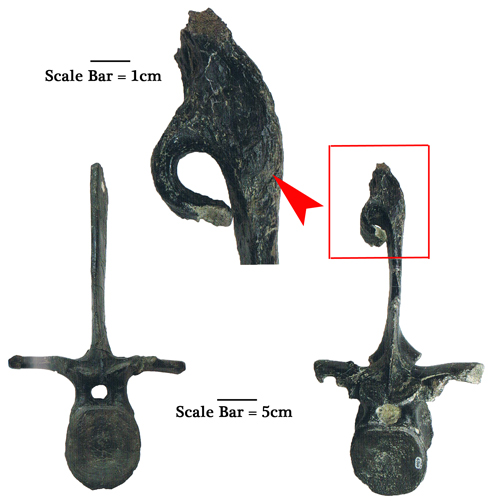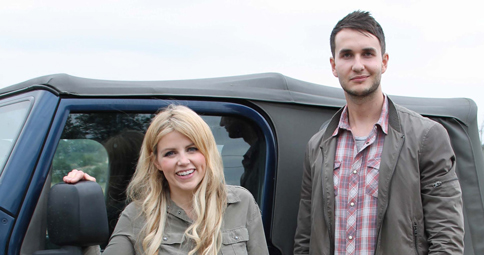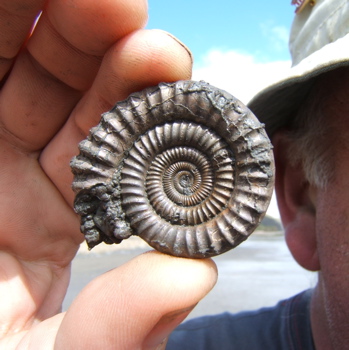Exclusive Dinosaur Britain Programme – Part 2 Reviewed
A Review of Dinosaur Britain – Part 2
The second part of Maverick TV’s “Dinosaur Britain” aired on terrestrial television last night (ITV1). Once again, presenter Ellie Harrison was joined by palaeontologist and author Dean Lomax on an exploration of Britain’s dinosaur fauna. However, unlike the first programme with its emphasis very much on English dinosaurs, the two, intrepid investigators travelled into Scotland and Wales to help reveal some of the ancient animals that roamed these parts of the British Isles.
Dinosaurs from Britain
Plucky Ellie, who had coped with a very claustrophobic slate mine in programme one, was tasked with manning a row boat on Loch Ness. No Nessie to be seen, but an opportunity to introduce the idea that whilst dinosaurs dominated terrestrial habitats during the Mesozoic, the seas surrounding the land masses that were ultimately to become Britain, once teemed with marine reptiles such as plesiosaurs.
This had been touched upon in the first part of this two-part documentary series, when the idea of ichthyosaurs feeding on the carcases of drowned armoured dinosaurs was discussed and it was good to see the storyline brought up to the present when on the beach at Lyme Regis, the presenters were shown ichthyosaur vertebrae and a small bone, potentially from an Early Jurassic plesiosaur.
Dinosaur Britain – Fossil Hunting in the UK
The Diversity of British Dinosauria
If the objective of the television programmes was to demonstrate the diversity of British Dinosauria and to encourage people to try fossil hunting for themselves, then appetites were certainly whetted when some of the children’s fossil finds were shown, Ellie Harrison seemed genuinely excited to have found some belemnite guards.
Back to the dinosaurs and viewers were treated to a view of a sauropod wandering around Edinburgh, part of a segment that explained the importance of the Isle of Skye in terms of its contribution to our understanding of the dinosaurs of the Jurassic.
Steve Brusatte, (University of Edinburgh) enthusiastically introduced more dinosaur fossils from the British Isles. Steve is an American and we teased him last night when tweeting about seeing him discussing dinosaurs from this side of the Atlantic, when it is usually the dinosaurs known from the United States that tend to grab all the attention. Dr Brusatte took our gentle teasing in good spirit and he reminded us that it is because of British dinos that Steve has such a fantastic job!
The Isle of Skye
On the Isle of Skye, Dean explained to Ellie that the tri-dactyl footprint he had located on the beach was very much a case of “walking with dinosaurs” and this led to a viewing of a tiny dinosaur footprint, less than two centimetres in diameter. The fossilised print was discovered in Score Bay (Isle of Skye) and is thought to be the smallest dinosaur footprint ever found in Europe. Slightly bigger prints were revealed on a visit to a beach on the southern side of the Isle of Wight.
These tracks were made by iguanodonts, we suspect that the ones shown were examples of the natural casts from the foreshore of Hanover Point. Cue an opportunity to introduce all-round good guy Darren Naish (vertebrate palaeontologist and science writer), who outlined some of the pathology found on the fossilised bones of the huge predator Neovenator and this dinosaur’s potential prey the ornithopod Mantellisaurus atherfieldensis.
Mantellisaurus atherfieldensis
The resulting CGI showed the Neovenator accumulating all its injuries in just a few seconds as it pursued its victim, a little unlikely, but the important message here for the viewer, so eloquently relayed by Darren, is that the fossilised remains of long extinct animals can provide scientists with an insight into potential predator/prey interactions.
Interpreting the Evidence – Dorsal Vertebrae Assigned to M. atherfieldensis

Forensic examination of dinosaur bones can help to tell the story of the lives of long extinct animals.
Picture credit: “Dinosaurs of the British Isles”
Dorsal Vertebrae
The picture above shows two fossil back bones (dorsal vertebrae) from the ornithopod Mantellisaurus found in association with the theropod Neovenator (N. salerii). The bone on the left shows normal morphology with a tall, rectangular shaped neural spine. The bone on the right shows a traumatic injury on the neural spine (see inset). Bone re-growth in the area indicates that this iguanodontid lived for some time after this injury.
These pictures come from the excellent “Dinosaurs of the British Isles” book written by Dean Lomax and Nobumichi Tamura. This book provides a comprehensive overview of the dinosaurs of the entire British Isles and is highly recommended.
To learn more about “Dinosaurs of the British Isles” and to purchase: “Dinosaurs of the British Isles”.
Presenters Ellie Harrison and Dean Lomax

Programme two – features Cetiosaurus, Proceratosaurus, Iguanodontids, stegosaurs, Neovenator and even little Echinodon is depicted.
Picture Credit: ITV
Dinosaur Britain
Just one small point that was noted by a colleague, many of the measurements provided for the dinosaurs were given in feet. Old timers like the staff at Everything Dinosaur are well used to this, but with this programme aimed at a family audience including children, would very young viewers appreciate the size and scale of these prehistoric beasties when imperial measurements were used in some cases? Perhaps not, although the CGI showing the armoured Dacentrurus wandering the galleries of the Natural History Museum and the tiny Echinodon attacking a sandwich at least gave viewers an opportunity to gauge size for themselves.
Earliest Members of the Tyrannosauroidea
Time to introduce one of the earliest members of the Tyrannosauroidea clade, Proceratosaurus a very distant relative of the famous Tyrannosaurus rex. Ms Harrison was surprised to learn that this three metre long theropod once roamed around her home county of Gloucestershire.
To conclude the second programme, the viewer was brought right up to date and introduced to the very latest dinosaur to be added to the compendium of British dinosaurs. Found in Lower Jurassic rocks at Lavernock Point (Vale of Glamorgan, Wales), Dr Dave Martill (University of Portsmouth), showed off a remarkable fossil discovery, the partial skeleton of a small, agile meat-eating dinosaur that might turn out to be the oldest dinosaur specimen ever found in Jurassic aged strata. It was pleasing to see plenty of feathered Theropods throughout the two programmes.
A few days ago, Everything Dinosaur reported on the finding of more fossil bones associated with this specimen: Putting the Welsh Theropod on a Firmer Footing.
Dinosaurs Awaiting Discovery
It seems that there are more dinosaurs awaiting discovery in the rocks of the British Isles. Thanks to Maverick TV the British public has gained an appreciation of our rich dinosaur heritage. A quick nod to the schedulers, the earlier start time of 8pm would have been appreciated by mums and dads. Showing the programme an hour earlier than the first episode would have permitted more children to stay up and watch.
Commenting on Dinosaur Britain
Let’s leave the last word to Dean, who summed up this two-part documentary succinctly:
“Despite Britain playing a pivotal role in the development and understanding of dinosaurs and palaeontology worldwide, in a modern capacity Britain has somewhat been overlooked. Personally, I feel that Dinosaur Britain is a huge opportunity to put us on the map for dinosaur discoveries, tell the unique story it has and most importantly enthuse people of all ages to learn more about British palaeontology. Who knows, Dinosaur Britain may just be the very programme that inspires future British palaeontologists.”
Well said.


